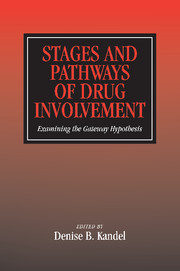Book contents
- Frontmatter
- Contents
- List of Contributors
- Foreword
- Preface
- Part I Overview
- Part II Recent Substantive Findings: What Do We Know About Stages of Drug Use, Risks, and Protective Factors?
- Part III Impact of Prevention Interventions: A Test of the Progression Hypothesis
- Part IV Methodological Issues and Approaches: Advantages and Limitations of Alternate Methods
- 9 Log Linear Sequence Analyses: Gender and Racial/Ethnic Differences in Drug Use Progression
- 10 Cigarette Use and Drug Use Progression: Growth Trajectory and Lagged Effect Hypotheses
- 11 Using Latent Transition Analysis to Examine the Gateway Hypothesis
- 12 Stages of Drug Use Progression: A Comparison of Methods, Concepts, and Operationalizations
- Part V Animal Models and Biological Processes: Implications for Drug Progression
- Part VI Conclusion
- Index
9 - Log Linear Sequence Analyses: Gender and Racial/Ethnic Differences in Drug Use Progression
Published online by Cambridge University Press: 25 July 2009
- Frontmatter
- Contents
- List of Contributors
- Foreword
- Preface
- Part I Overview
- Part II Recent Substantive Findings: What Do We Know About Stages of Drug Use, Risks, and Protective Factors?
- Part III Impact of Prevention Interventions: A Test of the Progression Hypothesis
- Part IV Methodological Issues and Approaches: Advantages and Limitations of Alternate Methods
- 9 Log Linear Sequence Analyses: Gender and Racial/Ethnic Differences in Drug Use Progression
- 10 Cigarette Use and Drug Use Progression: Growth Trajectory and Lagged Effect Hypotheses
- 11 Using Latent Transition Analysis to Examine the Gateway Hypothesis
- 12 Stages of Drug Use Progression: A Comparison of Methods, Concepts, and Operationalizations
- Part V Animal Models and Biological Processes: Implications for Drug Progression
- Part VI Conclusion
- Index
Summary
This chapter, a companion to Chapter 4, clarifies the logic underlying the notion of stages of drug use progression and its relation to two related models for the analysis of progressions. These log linear models were introduced in our previous research (Yamaguchi & Kandel, 1984a; Kandel, Yamaguchi, & Chen, 1992; Kandel & Yamaguchi, 1993; Yamaguchi & Kandel, 1996) and are further refined here. The models are applied to gender/ethnic differences in progression patterns among five drugs: alcohol, cigarettes, marijuana, cocaine, and heroin. The models that underlie the substantive results presented in Chapter 4 are discussed in detail in this chapter to illustrate the use of the methods.
In order for a stage of progression in drug use to be substantiated, two conditions must be met (Yamaguchi & Kandel, 1984a; 1984b). The first condition is that of a sequential order between two states. The sequential order of initiations between a lower-stage drug A and a higher-stage drug B is such that all systematic pathways of drug use progression, except random progressions, must not include the reverse sequence B-A (Yamaguchi & Kandel, 1984a). As a result, all pathways of progression other than the random type fall into one of the following three groups: (1) reaches neither stage A nor B; (2) reaches only stage A; and (3) reaches both stages A and B, stage A first. Under these conditions, the pathways of drug use progression satisfy the condition that stage A must precede stage B.
Information
- Type
- Chapter
- Information
- Stages and Pathways of Drug InvolvementExamining the Gateway Hypothesis, pp. 187 - 222Publisher: Cambridge University PressPrint publication year: 2002
Accessibility standard: Unknown
Why this information is here
This section outlines the accessibility features of this content - including support for screen readers, full keyboard navigation and high-contrast display options. This may not be relevant for you.Accessibility Information
- 3
- Cited by
